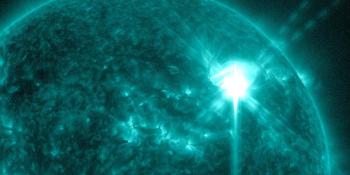Viewing archive of wtorek, 31 maja 2011
Raport aktywności słonecznej
Any mentioned solar flare in this report has a scaling factor applied by the Space Weather Prediction Center (SWPC). Because of the SWPC scaling factor, solar flares are reported as 42% smaller than for the science quality data. The scaling factor has been removed from our archived solar flare data to reflect the true physical units.
Raport aktywności słoneczno- geomagnetycznej 2011 May 31 2200 UTCPrzygotowane przez NOAA © SWPC i przetworzone przez SpaceWeatherLive.com
Połączenie raportów USAF/NOAA o słonecznej i geofizycznej aktywności
Numer SDF 151 wydany w 2200Z na 31 May 2011IA. Analiza aktywności regionów słonecznych i aktywność od 30-2100Z do 31-2100Z Solar activity has been low. Region 1226 (S22E27) and
Region 1227 (S18E39) each produced C1 x-ray events in the past 24
hours. Region 1226 was classified as a Dhc group with Beta magnetic
characteristics while Region 1227 was a Dsi group with more complex
Beta-Gamma characteristics. Region 1228 (N17E50) rapidly evolved
into a Cso type group as new trailing spots emerged. New Region
1230 (N19E58) was numbered today. This new region, and the remainng
regions, were generally quiescent, small and magnetically simple.
IB. Prognoza aktywności słonecznej
Solar activity is expected to be low,
with a slight chance for M-class events for the next three days (1 -
3 Jun).
IIA. Podsumowanie aktywności geofizycznej 30-2100Z do 31-2100Z
The geomagnetic field ranged from quiet to active levels over the
past 24 hours. Heliospheric imagery from STEREO-B suggests the
increased activity was the result of a transient, weak CME. The
greater than 2 MeV electron flux at geosynchronous orbit reached
high levels during the period.
IIB. Prognoza aktywności geofizycznej
The geomagnetic field is
expected to be unsettled to active on day 1 (01 Jun) , quiet to
unsettled on day 2 (02 Jun), and unsettled to active on day 3 (03
Jun). ENLIL model output indicates the passage of the 29 May CME
early on day 1. A brief return to generally quiet conditions on day
2 is followed by disturbed conditions on day 3 as a recurrent
coronal hole high speed stream begins to influence the
magnetosphere.
III. Prawdopodobieństwa zdarzenia 01 Jun do 03 Jun
| Klasa M | 20% | 20% | 20% |
| Klasa X | 01% | 01% | 01% |
| Proton | 01% | 01% | 01% |
| PCAF | green | ||
IV. Przepływ 10,7 cm z Penticton
Zaobserwowano 31 May 112 Przewidywane 01 Jun-03 Jun 115/115/110 Średnia z 90 dni 31 May 108
V. Indeks geomagnetyczny A
Zaobserwowano Afr/Ap 30 May 007/009 Szacowane Afr/Ap 31 May 010/012 Przewidywane Afr/Ap 01 Jun-03 Jun 010/010-007/008-010/010
VI. Prawdopodobieństwa aktywności geomagnetycznej 01 Jun do 03 Jun
| A. Średnie szerokości geograficzne | |||
|---|---|---|---|
| Aktywne | 20% | 10% | 20% |
| Słaba burza | 10% | 05% | 10% |
| Bardzo znacząca burza | 05% | 01% | 05% |
| B. Wysokie szerokości geograficzne | |||
|---|---|---|---|
| Aktywne | 20% | 15% | 20% |
| Słaba burza | 25% | 10% | 20% |
| Bardzo znacząca burza | 10% | 05% | 15% |
<< Idź do codziennego przeglądu
Najnowsze wiadomości
Najnowsze wiadomości z forum
AR3663 239AR3664 86Incoming Active Regions 238Sporadic E and Flare activity 21Filaments and prominences 79
Więcej tematówWesprzyj SpaceWeatherLive.com!
Wielu ludzi odwiedza SpaceWeatherLive aby śledzić aktywność słoneczną lub sprawdzić czy jest szansa na zaobserwowanie zorzy polarnej. Niestety, większy ruch na stronie oznacza większe koszty utrzymania serwera. Dlatego, jeśli jesteś zadowolony ze strony SpaceWeatherLive, zachęcamy do wspierania nas finansowo. Dzięki temu będziemy mogli utrzymać naszą stronę.

Fakty na temat pogody kosmicznej
| Ostatnie rozbłyski klasy X | 2024/05/06 | X4.52 |
| Ostatnie rozbłyski klasy M | 2024/05/07 | M8.1 |
| Ostatnia burza geomagnetyczna | 2024/05/06 | Kp5 (G1) |
| Spotless days | |
|---|---|
| Ostatni dzień bez skazy | 2022/06/08 |
| Monthly mean Sunspot Number | |
|---|---|
| kwietnia 2024 | 136.5 +31.6 |
| Last 30 days | 159 +66.6 |


